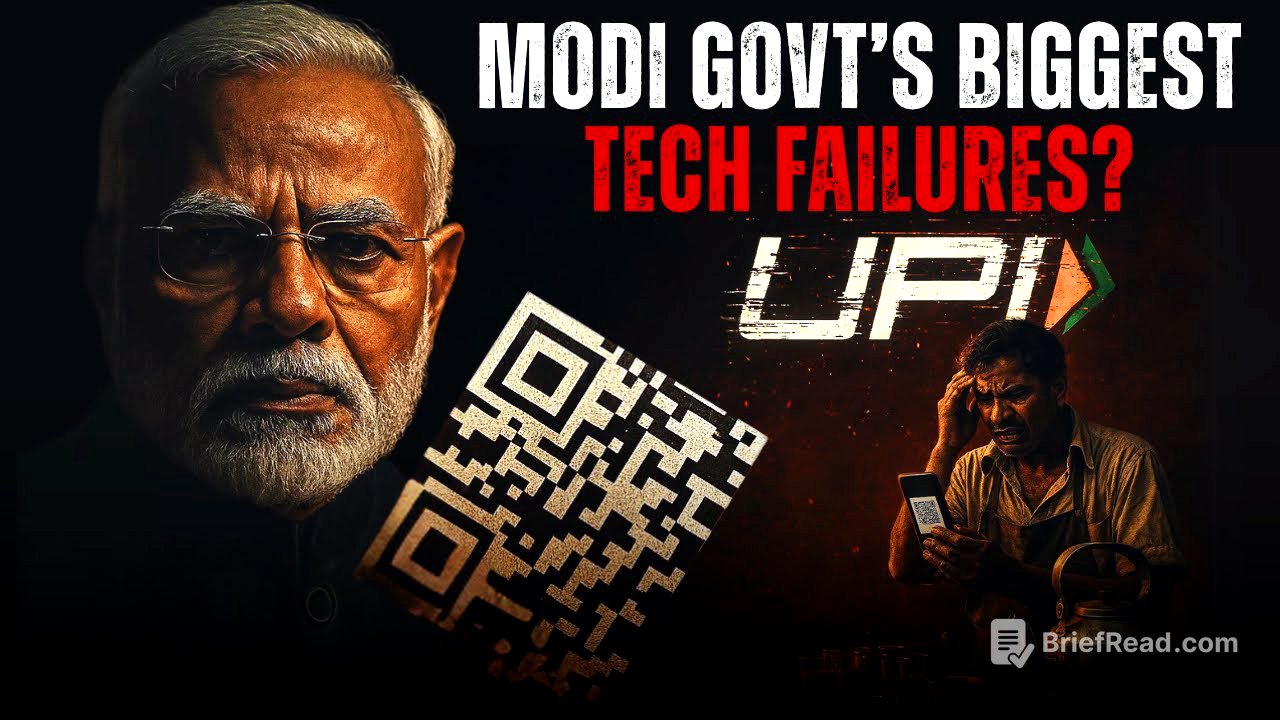TLDR;
This video talks about the success of UPI and the Digital India initiative, while also pointing out the gaps and failures of other initiatives like ONDC and Okin. It highlights the importance of execution, incentives for private players, and the need for startup innovation and transparency from the government.
- UPI has been a phenomenal success, but there are still gaps that present multi-million dollar startup opportunities.
- ONDC faces challenges with user experience, logistics, marketing, and awareness.
- Okin has struggled with adoption due to reluctance from major banks and regulatory issues.
- The government needs to focus on execution, providing incentives for private players, and fostering startup innovation to make these initiatives successful.
- Transparency and regular updates are crucial for building trust with the public.
Introduction: UPI Success and the Unfulfilled Promises of ONDC and Okin [0:00]
The Modi government has been promoting the success of UPI and the Digital India initiative, with India showing rapid growth in digital payments. While UPI transactions are booming, initiatives like ONDC (Open Network for Digital Commerce) and Okin (Open Credit Enablement Network) have not lived up to their promises. ONDC's app is subpar, and Okin has been largely ignored by major banks. The video aims to analyse the gaps in UPI, the reasons for the slow progress of ONDC and Okin, and the lessons to be learned from these experiences.
India Stack: The Foundation of Digital Infrastructure [3:50]
India Stack is a digital infrastructure comprising identity, payments, and data management layers. It includes applications like Aadhaar, UPI, and Digilocker. India Stack is structured as a four-layer system: the presenceless layer (Aadhaar for identity verification), the paperless layer (Digilocker for digital document storage), the cashless layer (UPI for instant payments), and the consent layer (account aggregator system for sharing financial data). While India Stack was intended to create a digital superpower, even UPI has significant gaps that present opportunities for startups.
Gaps in UPI and Opportunities for Startups [5:50]
Despite UPI's success, there are gaps that startups can address. For example, companies like Cashbook provide UPI-based business wallets to manage vendor payments, reducing reconciliation time and leakage expenses. There is also a need for UPI solutions for salary and contract payments, as current options are time-consuming, messy, or expensive. Another gap exists for high-value B2B transactions using UPI. Addressing these gaps can lead to significant business opportunities.
ONDC: Open Network for Digital Commerce [7:20]
ONDC is a government-backed online retail network designed to help small retailers go online and reduce the dominance of major players like Amazon and Flipkart. It operates as a network of networks, allowing different buyer apps, seller apps, and logistics providers to interact on a common platform. ONDC has facilitated over 200 million transactions and onboarded over five lakh sellers, with a significant portion being MSMEs. However, it faces challenges related to user experience, lack of an integrated logistics network, limited marketing firepower, and low user awareness.
Challenges and Potential Solutions for ONDC [9:11]
ONDC's user experience is a major concern, with complaints about irrelevant search results and poor delivery times. Unlike Amazon and Flipkart, ONDC lacks a seamlessly integrated logistics network and the financial resources for extensive marketing and discounts. To succeed, the government needs to address these issues by improving logistics, increasing marketing efforts, and ensuring financial viability for sellers. Balancing fees is also crucial to avoid creating new problems.
Okin: Open Credit Enablement Network [10:58]
Okin is a government-led initiative aimed at democratising access to credit for small businesses and individuals excluded from traditional banking systems. It allows businesses to apply for loans using Aadhaar, share GST records and transaction history via account aggregators, and receive instant loan approvals and funds via UPI. However, Okin has faced challenges due to the reluctance of major banks to fully participate.
Reasons for Okin's Limited Success and the Need for Transparency [12:11]
Major banks have been reluctant to participate in Okin due to fears of losing direct control over customer relationships. Unlike UPI, banks are not obligated to adopt Okin, and they can ignore it without consequences. Additionally, regulatory and operational failures in early pilots, such as repayment collection issues, have led to higher-than-expected defaults. The lack of official updates on Okin's progress since early 2024 raises concerns about its future. Transparency and regular updates are needed to build trust and inform the public about the initiative's progress and challenges.
Lessons Learned: Vision, Incentives, and Startup Innovation [15:18]
Several lessons can be learned from the experiences of UPI, ONDC, and Okin. First, vision without execution is just PR. Government initiatives need follow-ups, incentives, and user feedback loops to succeed. Second, private players need incentives to participate. Okin and account aggregators failed to attract banks because there was no incentive or regulation forcing their participation. Finally, India Stack needs startup innovation, not just state support. UPI exploded because startups built amazing layers on top of the public rails, while ONDC and Okin tried to scale without startup innovation.









